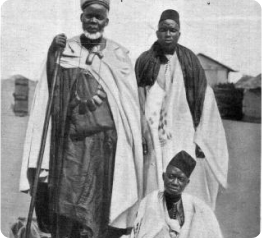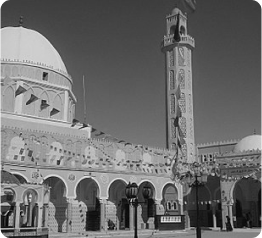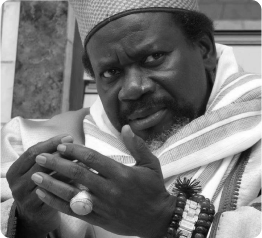Al-Hajj Abdoulaye Niasse
By Zakariya Wright
Al-Hajj Abdoulaye (1845-1922) was one of the greatest scholars of the Senegambia region in the early twentieth century. One time Jihadist and subsequent farmer, he was the first to obtain the unlimited authorization (ijaza mutlaqa) in the Tijaniyya in the Senegambia and was famous for his teachings on a wide range of Islamic sciences. The French commandant in Nioro, Senegal, observed in 1898: “Abdoulaye is the leader of all the marabouts of Rip and of Saloum, and is superior to all of them – consequently, he enjoys a great authority over the masses” (Klein, p. 224).
Mamadou Niasse, the father of al-Hajj Abdoulaye, was also a marabout, or Islamic scholar, who immigrated to the Saloum region from Djoloff and founded his own village of Niacene in 1865. This was at the time of the religious wars of al-Hajj Umar Futi, carried out in the Saloum region by another Tijani, Ma Ba Diakhou. Abdoulaye would later participate in the war as an advisor to Saer Maty, the son of Ma Ba who assumed leadership of the movement after his father was assassinated by French intrigue. He soon dissociated himself from the jihad however, and devoted himself exclusively to teaching and farming. Like his father, he also founded his own village, Taiba Niacene. But the memory of his participation in the jihads, along with his growing local influence, was too much for the new French-appointed rulers in the region. In 1900, he and 200 of his disciples were forced to flee to Gambia by the French-appointed governor, even as three villages belonging to his followers, including Taiba Niacene and the central mosque and extensive library therein, were burned to the ground. Abdoulaye only returned to the Saloum region in 1910, when he installed himself finally in Kaolack, probably only after the intervention of his friend, al-Hajj Malik Sy, with the French authorities.
Al-Hajj Abdoulaye made several journeys abroad. He accomplished the pilgrimage to Mecca as early as 1890. Other travels brought him to Fes, Cairo and, according to Paul Marty, even Marseille, France. He is said to have been given an ijaza by al-Azhar University during his stay in Egypt. In Fes, he was given an original manuscript of the Jawahir al-Ma’ani in the handwriting of Sidi Ali Harazim, which had been in the possession of Shaykh Ahmad Tijani himself for more than ten years. He also met with Shaykh Ahmad Tijani in a waking vision and obtained some of the Shaykh’s prayer beads from the head muqaddam of the Fes zawiya, Sidi al-‘Arabi bin Muhibb. Besides the ijaza mutlaqa, he also came to Fes praying Allah that one of his children would become the “savior of the age” (ghawth al-zaman). Before he left the Tijani zawiya in Fes, he saw a vision of his young son Ibrahim in the courtyard and knew all his prayers had been answered.
First initiated into the Tijaniyya through the silsila of al-Hajj Umar Futi at the hand of Shaykh Mamadou Diallo in 1875, al-Hajj Abdoulaye became connected with some of the most eminent Tijani scholars of his time. In Morocco, it was the renowned Shaykh Ahmad Sukayrij who gave al-Hajj Abdoulaye the ijaza mutlaqa. Shaykh Sukayrij would later mention al-Hajj Abdoulaye in one of his poems. Al-Hajj Abdoulaye also also remained on excellent terms with Sharif Ahmad bin Saih of Ain Maadi, Algeria (who visited him in Gambia and Senegal in 1909 and 1913), and Muhammad Ould Shaykh of the influential Mauritanian Idaw Ali tribe.
He also remained in close correspondence with al-Hajj Malik Sy. When he first met Shaykh Sukayrij to request the ijaza mutlaqa, the Moroccan Qadi informed him of a letter he had already received from al-Hajj Malik requesting the same. Shaykh Sukayrij told al-Hajj Abdoulaye to tell his friend and countryman to come to Fes in person the same way he had done. Al-Hajj Abdoulaye responded that whatever he himself was deserving of, his peer al-Hajj Malik was also deserving of the same. As a result of this intervention and their long-time friendship, al-Hajj Malik requested al-Hajj Abdoulaye to stay with him in Tivaouane on his return from Fes. During al-Hajj Abdoulaye’s time in Tivaouane, according to Shaykh Hassan Cisse, al-Hajj Malik would direct all requests for initiation into the Tijaniyya to his distinguished guest.
Al-Hajj Abdoulaye had many children who continued his scholarly mission. His first son, Muhammad Khalifa Niasse was a prolific author and scholar who traveled widely. Among other things, Muhammad wrote a remarkable defense of the Tijaniyya which has been translated into French by Ousmane Kane in Triaud and Robinson (eds.), La Tijaniyya (Paris, 2000). But it was one of his younger sons, Shaykh al-Islam Ibrahim Niasse, who became the greatest testament to al-Hajj Abdoulaye’s scholarly legacy.
Sources: Martin Klein, Islam and Imperialism in Senegal (Stanford, 1968); Paul Marty, L’Islam en Mauritanie et au Senegal (Paris, 1915); interviews with Shaykh Hassan Cisse.




